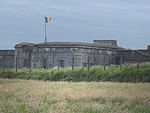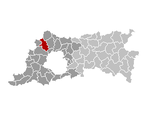Londerzeel
Flemish Brabant geography stubsMunicipalities of Flemish BrabantPages with Dutch IPA

Londerzeel (Dutch pronunciation: [ˈlɔndərzeːl]) is a municipality located in the Belgian province of Flemish Brabant. The municipality comprises the towns of Londerzeel proper, Malderen, Steenhuffel (home of Palm Breweries) and Sint-Jozef. On 1 January 2006, Londerzeel had a total population of 17,435. The total area is 36.29 km2 which gives a population density of 480 inhabitants per km2. Their football team is K. Londerzeel S.K.
Excerpt from the Wikipedia article Londerzeel (License: CC BY-SA 3.0, Authors, Images).Londerzeel
Brusselsestraat,
Geographical coordinates (GPS) Address Nearby Places Show on map
Geographical coordinates (GPS)
| Latitude | Longitude |
|---|---|
| N 51 ° | E 4.3 ° |
Address
Groene Long Londerzeel
Brusselsestraat
1840 (Londerzeel)
Flemish Brabant, Belgium
Open on Google Maps










